Cleaning out the bait freezer. It’s a messy, mostly thankless task rummaging through shopping bags of this and that, discovering those good baits you put away months ago were in there after all but are now freezer-burnt, bent out of shape and fit only for berley.
The freezer sides are wearing a thick layer of permafrost, while the base is a slushy red pool of salty fish juice. The lid doesn’t shut properly and the motor seems to be running 24/7.
Then you discover some prime fillets that have slipped off the top of the pile and are now destined for the dog’s bowl.
And there’s nothing worse than rummaging through the chilly contents of a freezer at 4am, bleary eyed after a fitful night’s sleep, trying to work out precisely where the bloody bait is!
Time for some remedial action.
It takes a bit of discipline but a quarterly clean-out makes a bait fisho’s life so much easier.
For a while there I had three freezers going but now having two properly organised has meant that I’ve been able to shut one down. This has been a godsend, given the outrageous price of electricity these days.
If it hasn’t been done for a while, a freezer clean may resemble an archaeological dig. I never found a woolly mammoth in any of mine, but it wouldn’t have surprised me.
I also have an eclectic collection of weird critters that look like the cast from Monsters Inc. They’ve been recovered from the stomachs of fish (mostly tuna and mahi mahi), some of which have survived in a frozen state for over a decade and three house moves.
A clean freezer with no ice build-up works more efficiently. If the door or lid doesn’t shut properly due to ice accumulation, check that the seals are actually sealing.
I’m reliably informed that if you close the door on a piece of paper, you shouldn’t be able to pull it out.
If you can, it’s time to get the seals replaced, as the motor will be running more often to keep the temperature down and the contents in a frozen state.
During Summer game fishing sorties, a cord line sits on a big handcaster in the side pocket of my boat, ready to be fired out whenever we cross paths with a school of striped tuna.
These end up filleted, the flesh side given a generous coating of coarse salt and then wrapped individually in a sheet of the Sydney Morning Herald. (Curse Fairfax for dropping from broadsheet to tabloid page size – fillets are now harder to wrap!)
Salted fillets are like gold during Winter when the stripies are non-existent, and these form the nucleus of what’s in my bait freezer.
Just be mindful of the liquid that the salt draws out of the flesh. This is an especially toxic little brew that contributes to the slush in the bottom of the freezer. Double-bag the salted fillets so the goo is contained until it’s had a chance to solidify.
The rest of the freezer space is taken up with a box of IQF pillies, vacuum-packed baby mack tunas and frigates for summer Spaniard baits, berley and ice blocks.
For non-fishos, disposing of prawn, crab, lobster, bug, oyster or mussel shells is usually a smelly issue, especially during the warmer months.
If you put the word out around the neighbourhood that you’re happy to relieve them of such fine berley fodder, pretty soon you’ll have more than you’ll know what to do with. Give them a few fillets in return and they may even deliver door-to-door…
There’s something extremely satisfying about lifting a decent red aboard and having it spit up your berley, or discovering the same in the stomach contents at the filleting bench later. Ha ha, fish – fooled ya!
Chicken frames and bones also make good berley (just watch the incredible oil slick that floats away on the surface when you drop one over the side), so freeze the remnants of the Sunday night roast rather than throwing it in the bin.
The next snapper or flathead to have a chicken thigh bone in its gut certainly won’t be the last, either.
Berley gets allocated into ‘trip-sized’ bags inside a bigger bag, just to prevent any spillage, and then it’s just a matter of grabbing a bag before heading off.
As most anglers know by now, the key to better quality table fish is to kill the capture Iki Jime style and bleed it, then get it into an ice slurry.
A slurry consists of roughly three parts ice to one part seawater. If it burns your hands when you dig around for that last fish to fillet, you’ve got the brew about right.
Any fish that comes out of a slurry will be firm and therefore easier to fillet, the flesh will be whiter, and far tastier when cooked.
It is possible to make a slurry too cold, though, with the risk of partially freezing the meat. That’s especially with fine-scaled species like teraglin, so adjust the ice/seawater ratio to suit.
Saltwater ice makes a far better chilling medium than freshwater ice, taking longer to get cold but it stays colder longer. Fruit juice containers filled with frozen water make cheap ice blocks (some people also use them as their on-board water requirements), but there’s far more bang for your buck to be had by using saltwater instead — just don’t try drinking it.
It’s easy enough to make saltwater ice blocks up out of Tupperware or ice cream containers, but ice cream parlours have their wares delivered in the handy 34cm x 13cm x 13cm plastic containers pictured hereabouts, which make the best ice blocks bar none.
And, wouldn’t you know it, they’re the same length as the width of my icebox, so they stack neatly, too.
They also come with lids, so if using IQF pillies, you can load one up with a day’s supply (or a morning’s if you’re feeling confident), and know they’ll remain in top nick.
I periodically fill a 15L drum with seawater down at the boat ramp and this sits under the filleting bench to replace what ice blocks were used on any given fishing day.
Two saltwater blocks smashed up into big chunks are enough to keep two bags of party ice close to frozen, and combined with a couple of juice bottles, that catch is going to keep extremely well.
When dealing with seawater, just be mindful of not slopping any on the sides of or in the freezer. If it’s not mopped up straight away, the first sign is rusty spots, then over time the whole side will disappear. Ditto for ute trays!
Once the filleting session is over, there’s the issue of what to do with the fish frames, skins and heads.
With all that spare room in the freezer, these can be frozen and dumped at sea next trip out, or you can bury them in the vegetable garden to give that home-grown produce a real kick along.
Like an undertaker at a cemetery, it’s important to remember precisely where you buried the last lot, though, because digging in the wrong spot before the frames have decomposed can have stinky consequences.
And the final word on bait freezers is that if you ever unplug one for whatever reason, always, always, always remember to plug it back in!
Reads: 2557
The vege garden is a good place for fish frames. Just bury them deep enough that dogs and foxes can’t find them.
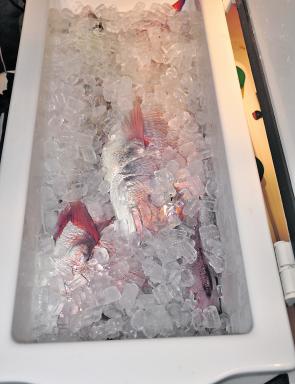
A bag of party ice over the slurried catch and it’s going to arrive home in tip-top condition.
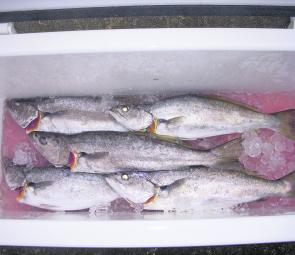
The perfect home for IQF pillies. If they don’t all get used, just throw a handful of salt on top and they’ll be good to go next time.
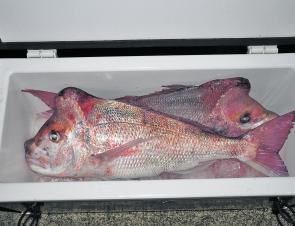
Almost too big for the box. Prime knobbies like these deserve to be treated with respect, so after the Iki Jime (brain piercing) treatment, bleed them and place into an ice slurry.

A well-organised bait and berley freezer means nothing is wasted and storage capacity is increased.

It’s possible to load up on fresh bait for occasions when it’s scarce. Vacuum packed, they’ll last forever.
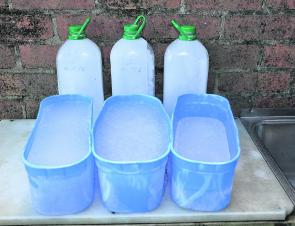
Trag can semi-freeze in a slurry, so be mindful of not making the mix too cold.
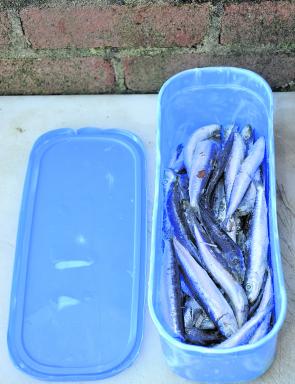
Ice cream containers like these are ideal for making your own saltwater ice blocks. Combined with some frozen drink bottles full of saltwater, and the catch will remain in excellent shape right up to filleting time.





